Featured Comment:
“I have tried so many different teriyaki recipes and this one was 1000000/10! So delicious, simple and fast. Ticks all the boxes. Cant wait to try it with tofu, chicken and other proteins. Thank you for sharing it with us ♥”
– @sanctuarysight4181 (from YouTube)
What is Teriyaki Salmon?
Teriyaki (照り焼き) is a Japanese cooking method that involves grilling or broiling meat or fish with a sweet sauce made from soy sauce, sake, mirin, and sugar. “Teri” means glossy or shiny, while “Yaki” means to fry or cook.
Although many people believe that teriyaki is just a sauce, it is actually a method of creating a sweet, sticky soy sauce glaze. You can use teriyaki cooking method for a variety of ingredients, but in Japan, the most popular is yellowtail or “Buri no Teriyaki”.
However, if you cannot find a yellowtail, salmon is a well-loved and widely accessible fish that goes perfectly with teriyaki!
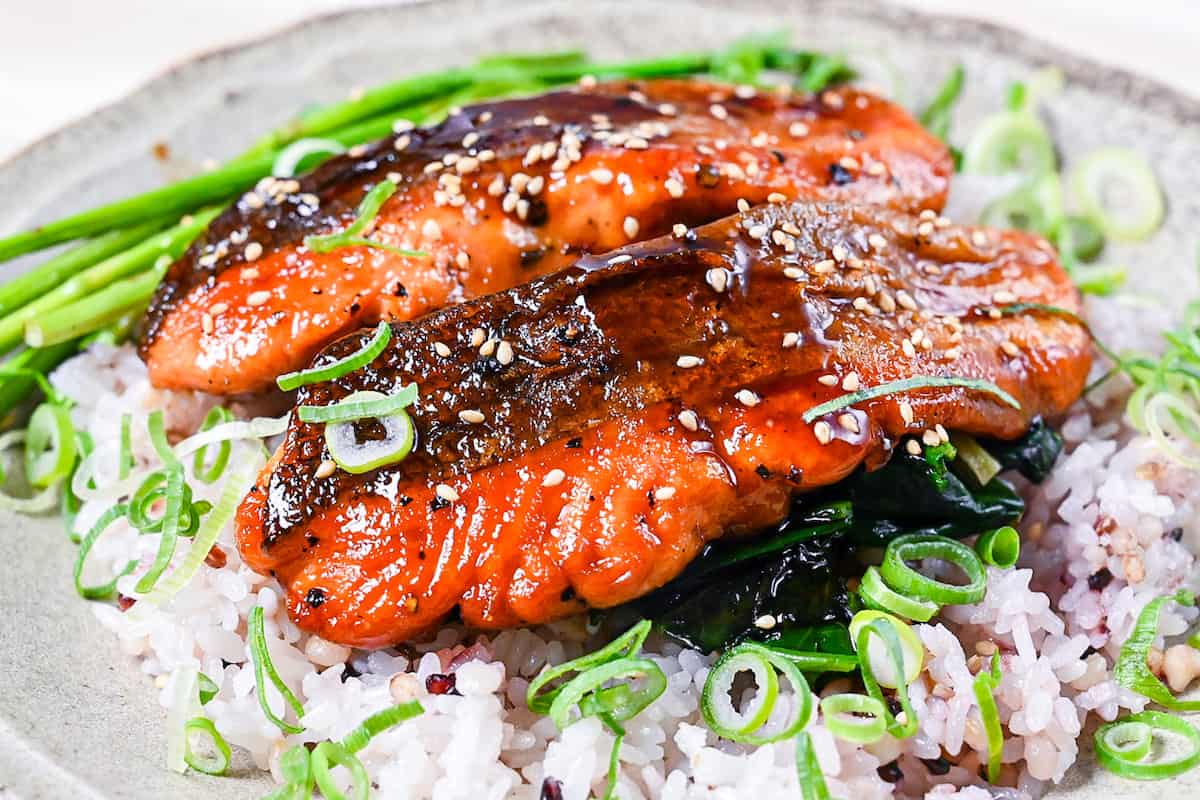

How I Developed This Recipe
I came up with a recipe that mixes Japanese and Western styles to create something more creative and unique than traditional Japanese.
In Japan, people usually eat meals in the form of a set, rather than a one-plate meal. However, I’ve adapted this teriyaki salmon recipe to be served in a one-plate meal.
The dish still has that authentic Japanese teriyaki flavor, and it’s served over rice, spinach, and asparagus sautéed in butter, which is the creative part!
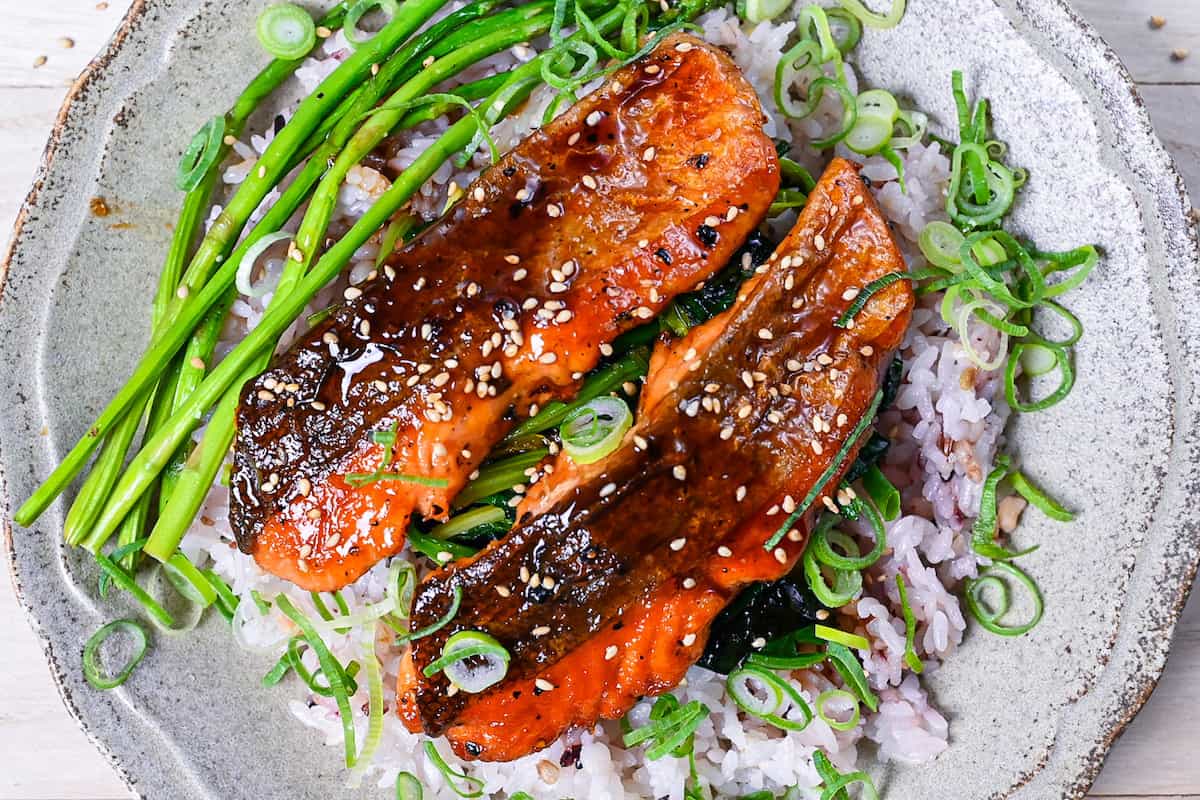
Ingredients & Substitution Ideas
- Salmon Fillets: Skin-on fillets are recommended for a crispy finish.
- Spinach: Chinese spinach or similar soft greens are perfect for this recipe. They add a lovely flavor and texture.
- Asparagus: I purposely opted for thin asparagus for a nice presentation, but any type works well!
- Unsalted Butter: Stick to unsalted to control the overall saltiness of the dish.
- Soy Sauce: For those interested in recommended brands, check out my comprehensive soy sauce guide!
- Mirin: “Hon mirin” (本みりん) is recommended for its authentic flavor.
- Sake: Pure, unsalted drinking sake is preferred for its clean flavor in cooking.
- Sugar: Your regular sugar is fine.
- Potato Starch: This, or cornstarch, works wonders for achieving that nice crispiness and thicker teriyaki glaze.
- Cooked Japanese Short-Grain Rice: Essential for this dish. Recommended Japanese rice available in the U.S. is explained in the How to Cook Japanese Rice Recipe.
- Garnish: A sprinkle of toasted sesame seeds and finely chopped green onion beautifully finishes the dish.
Curious about the exact brands and products that bring my recipes to life? Discover the brands and ingredients behind my recipes at the Sudachi Amazon Storefront. Explore my handpicked pantry essentials and find your next kitchen favorites!
Jump to Full Recipe Measurements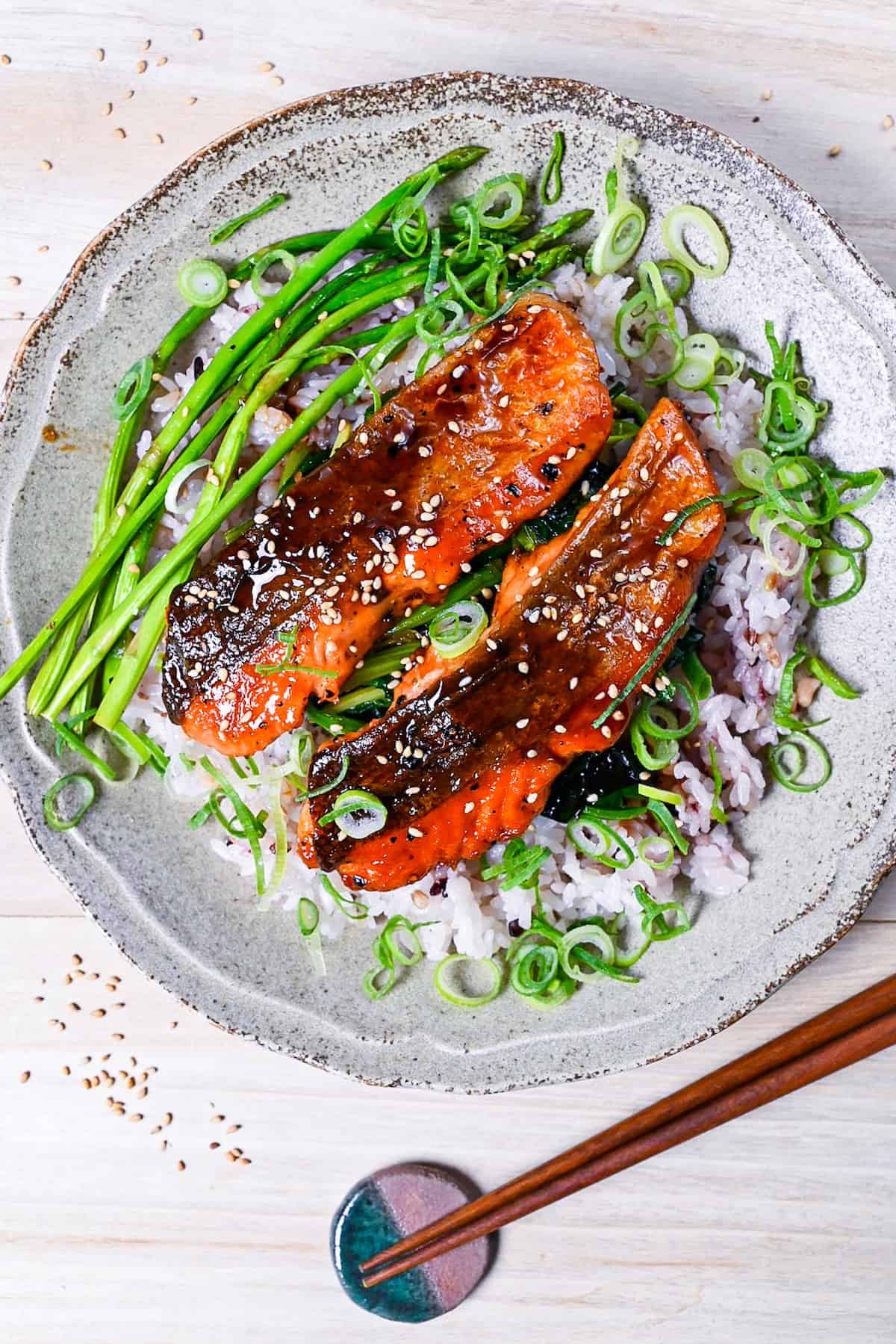
Visual Walkthrough & Tips
Here are my step-by-step instructions for how to make One-plate Teriyaki Salmon at home. For ingredient quantities and simplified instructions, scroll down for the Printable Recipe Card below.
In Japan, spinach is sold with the stems and roots attached. Here is how I prepare the spinach for frying. (If you buy spinach leaves, you can skip this step.)
Start by washing it thoroughly with cold water to remove any dirt or debris. Then divide it into 3 parts: the thick stems, the middle, and the top leaves like this:
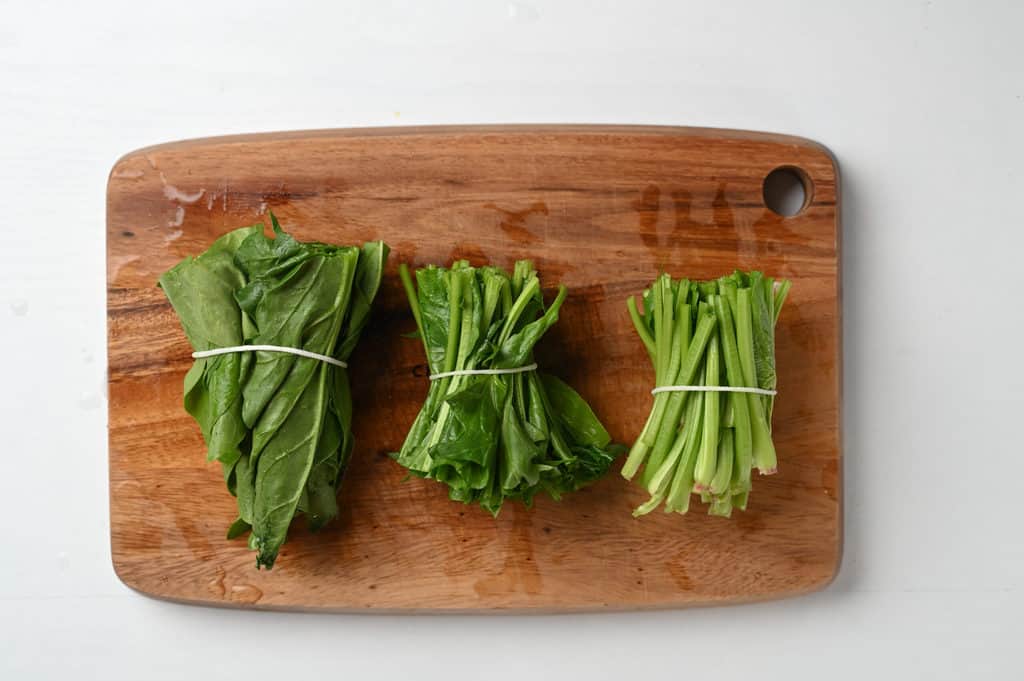
I tied them with butcher’s string to make removing them from the pan easy.
Blanching helps the spinach maintain its color and texture. Because the thick stems take longer to cook than the leaves, I blanch them at different times to ensure even cooking when we pan fry them later.
You will also need to prepare a bowl of ice-cold water to transfer the spinach once they’ve finished being blanched.
Bring a small pot of water to a boil and add a pinch of salt. Add the stems first and boil them for 1 minute.
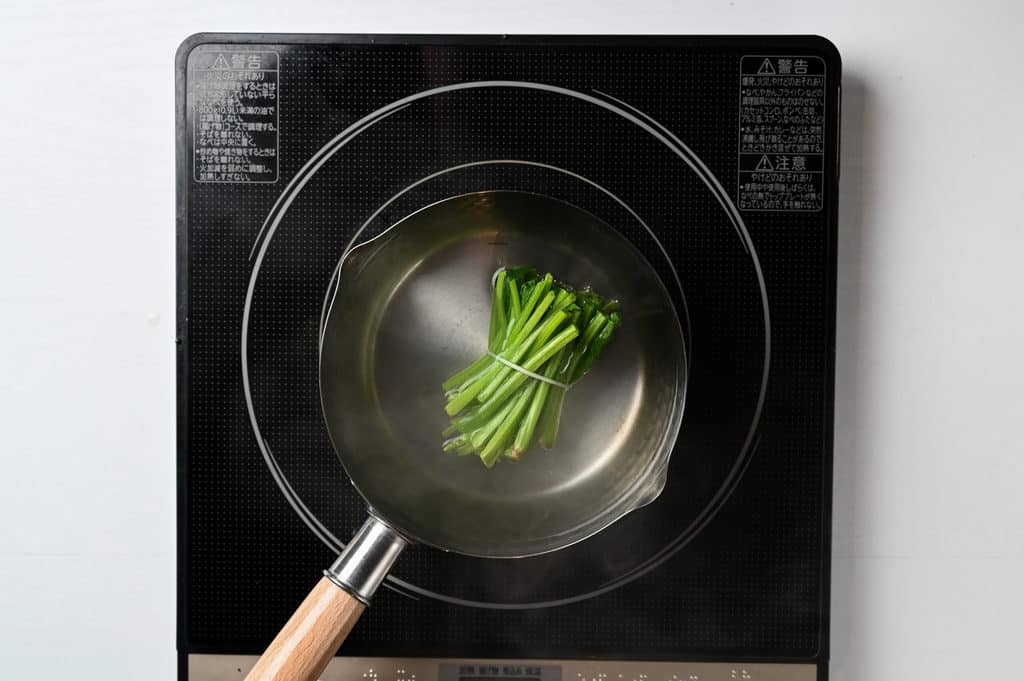
After 1 minute, add the middle part and boil for 45 seconds. (Leave the stems in there to continue boiling.)
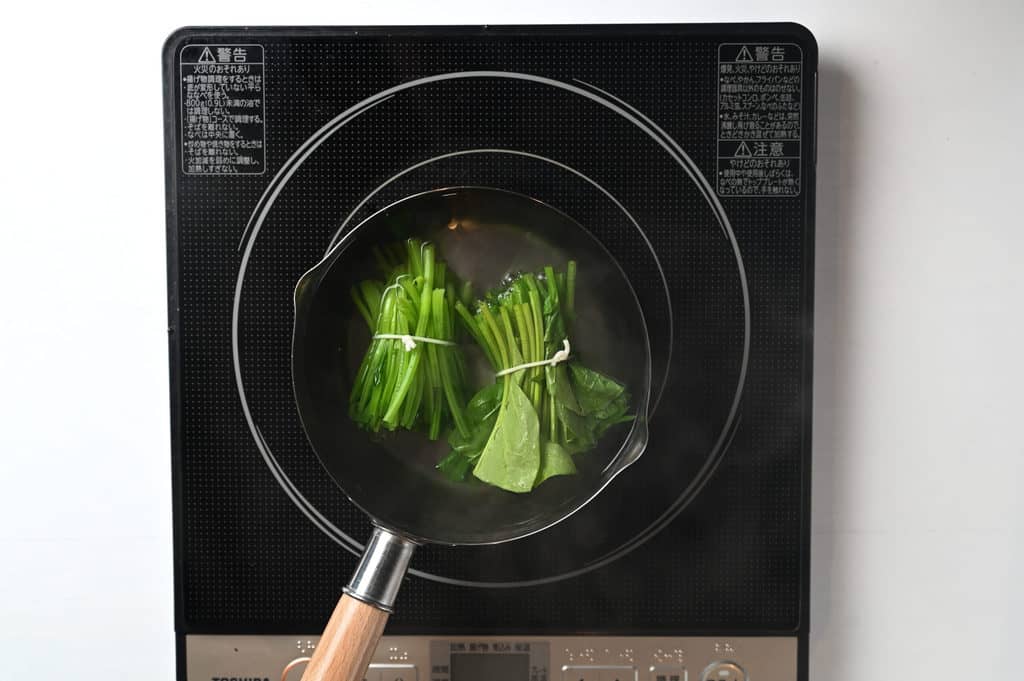
Add the top leaves and boil the whole spinach together for 30 seconds.
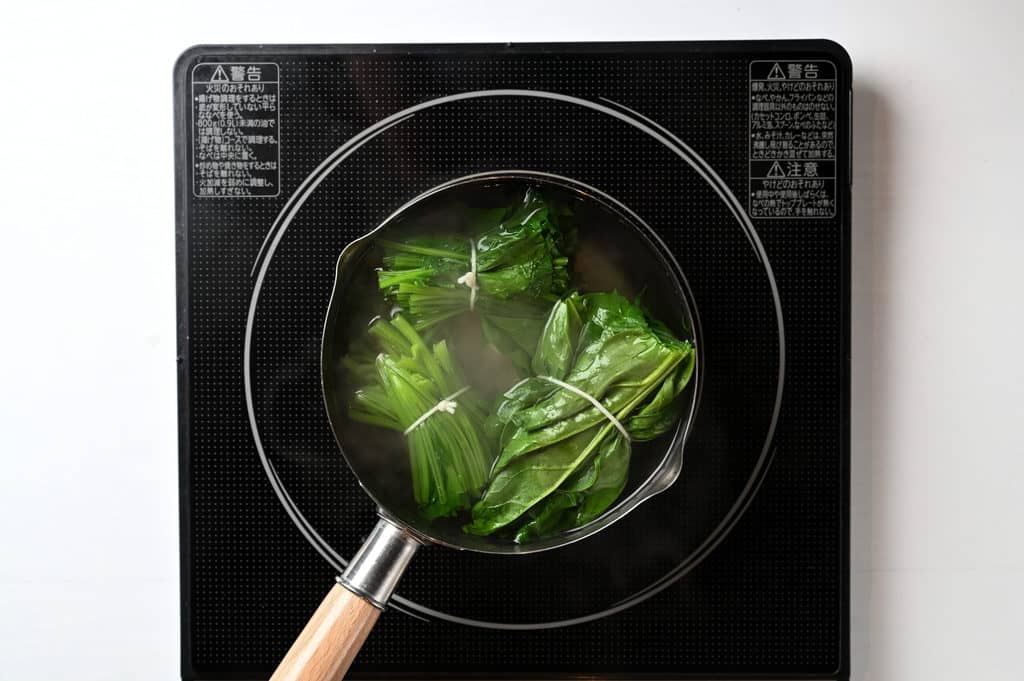
Once 30 seconds are up, use tongs to transfer each bundle to a bowl of ice-cold water. This will halt the cooking process.
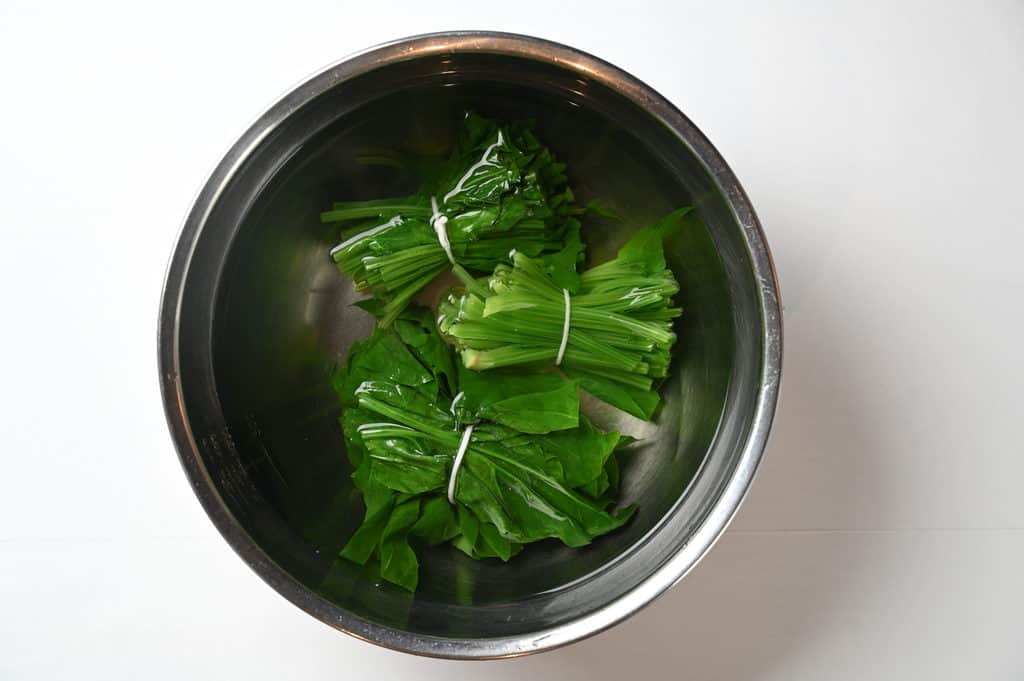
Finally, take each bundle out of the bowl, squeeze out the water, and place on a plate lined with kitchen paper to absorb any excess liquid.
Heat a pan on medium and add butter. Once the butter is melted, add the spinach and asparagus at the same time and sprinkle with a pinch of salt and pepper.
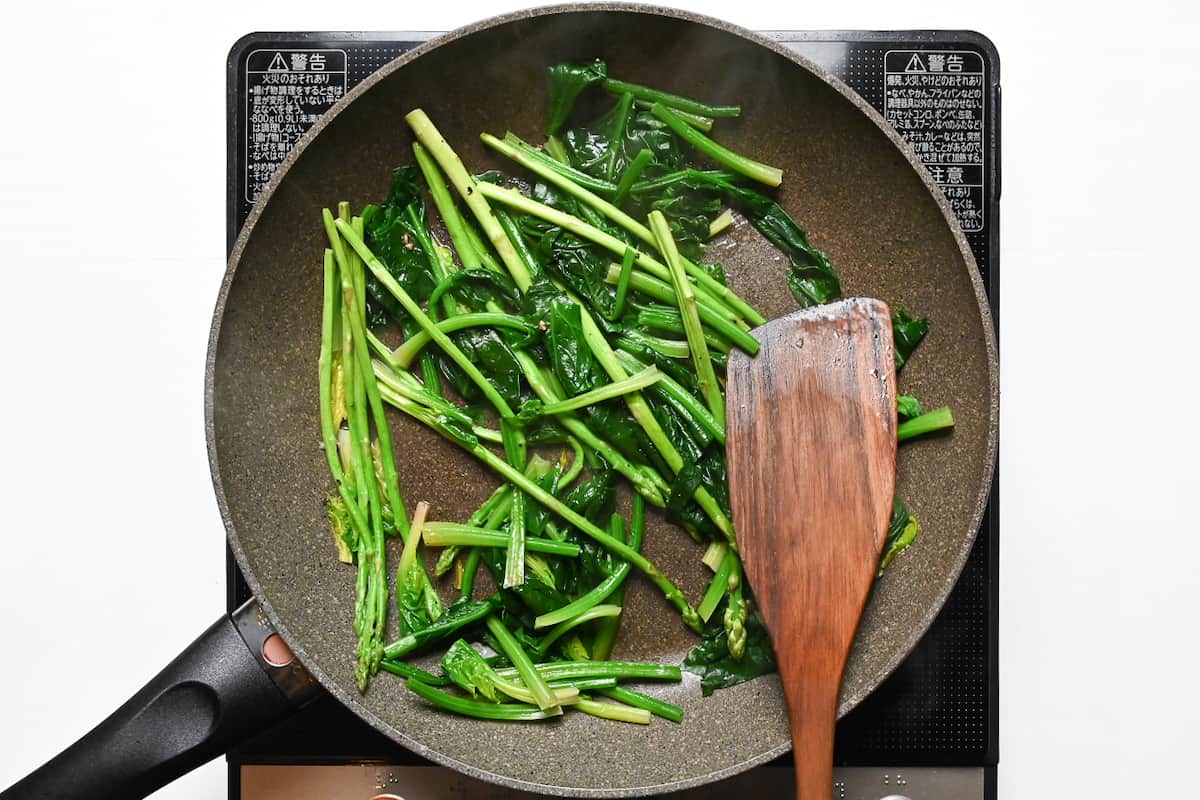
Stir fry for a few minutes until the asparagus is slightly softened, and remove it from the heat. Set aside for later.
Alternatively, if you have two stoves you can carry out this step halfway through cooking the salmon so that they’re ready at the same time.
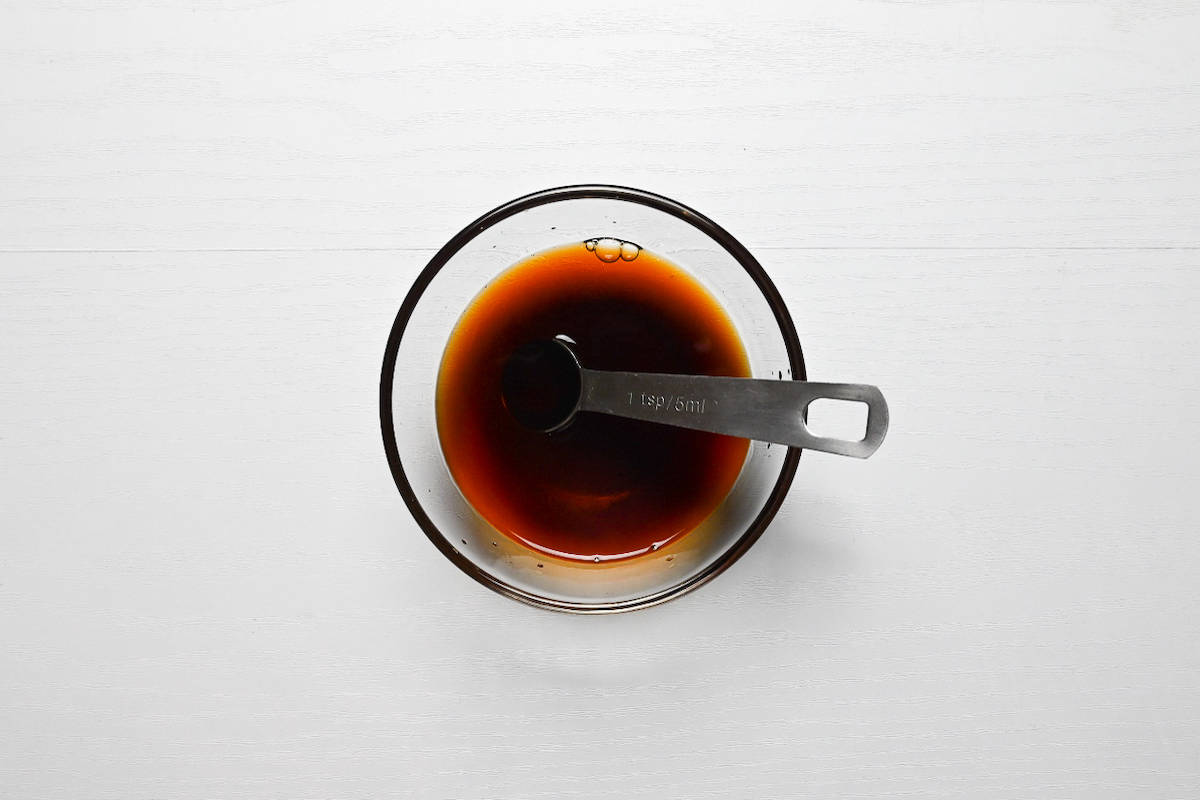
Mix soy sauce, sake, mirin, and sugar in a small bowl until the sugar is dissolved. Set aside for later.
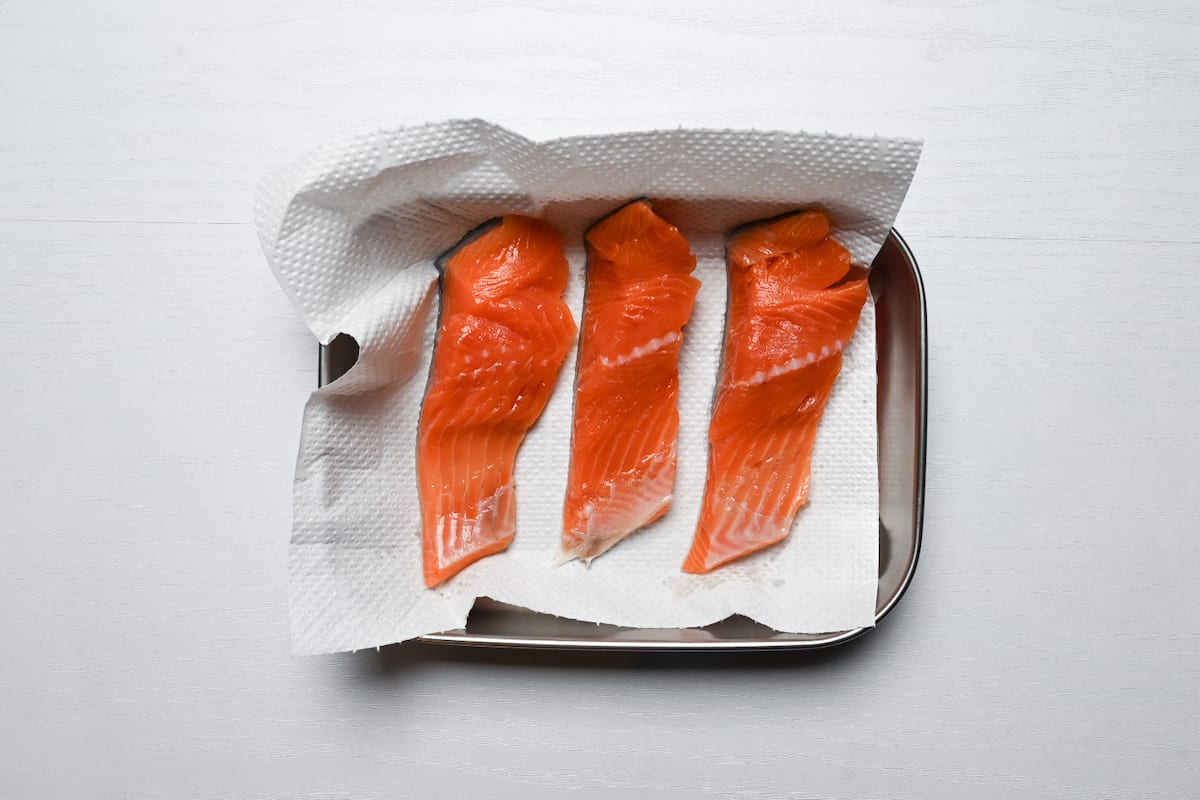
Dry the salmon on both sides using kitchen paper and sprinkle with a pinch of salt and pepper on both sides. Drying the salmon not only prevents them from sticking to the pan but also helps the skin crisp up more beautifully.
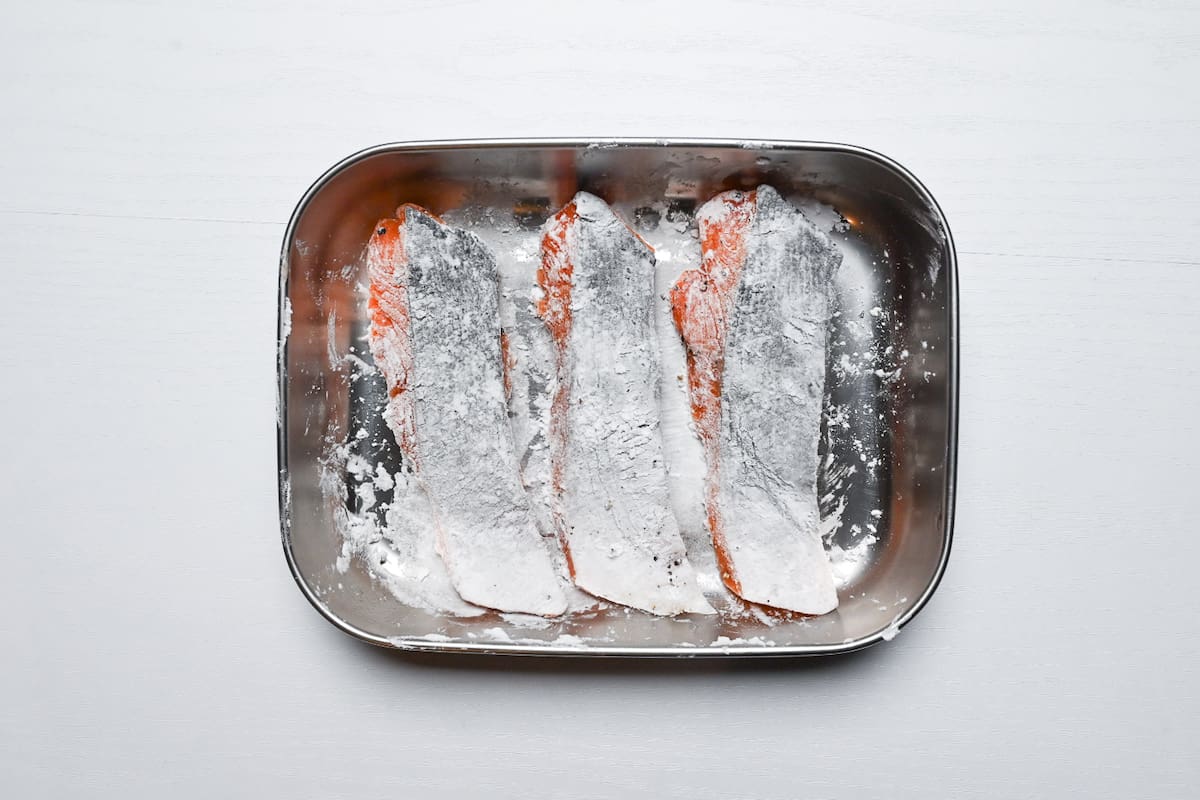
Next, coat with a thin layer of potato starch all over. This will crisp up the skin even further and also helps the teriyaki sauce stick to the surface better.
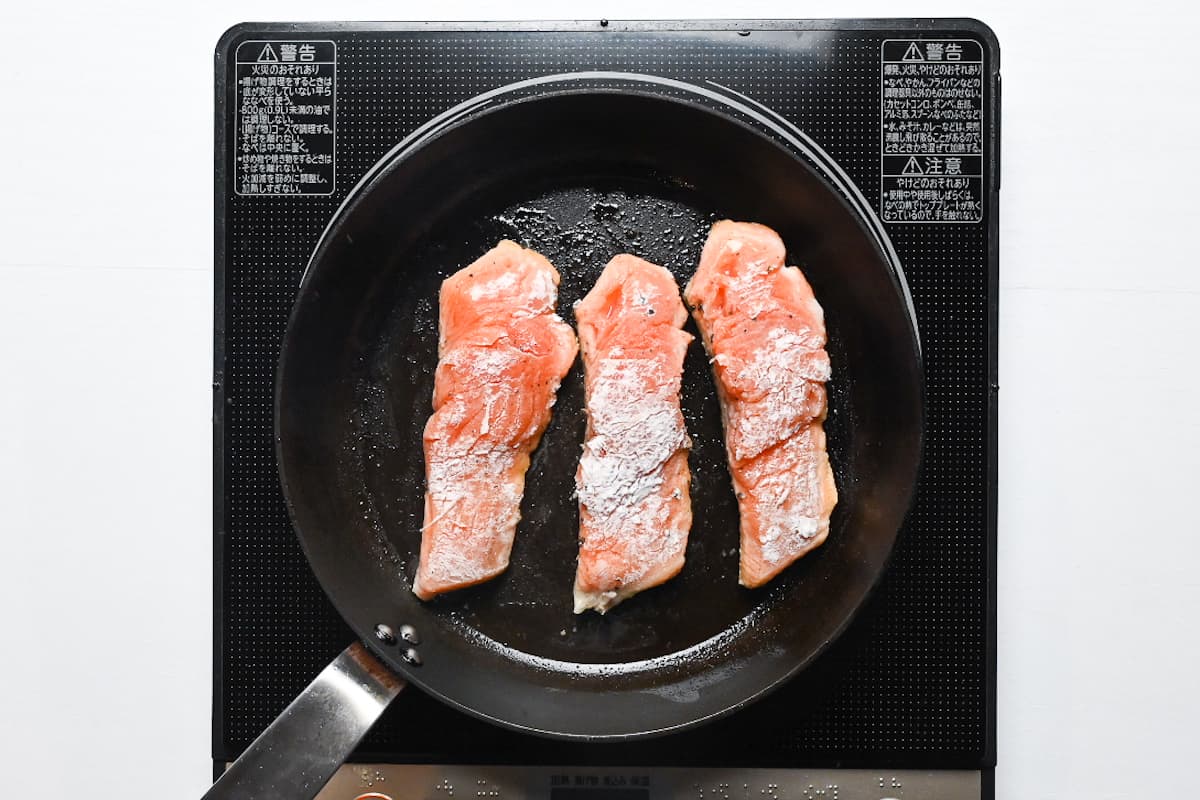
Heat a frying pan on medium. Once it’s hot, add a drizzle of oil and swirl it around so the pan is evenly coated. Place the salmon fillets with the skin side down and fry for 4 minutes. The cooking time is longer on this side to ensure the skin is extra crispy!
After 4 minutes, flip the salmon over and fry for 2 minutes on the other side.
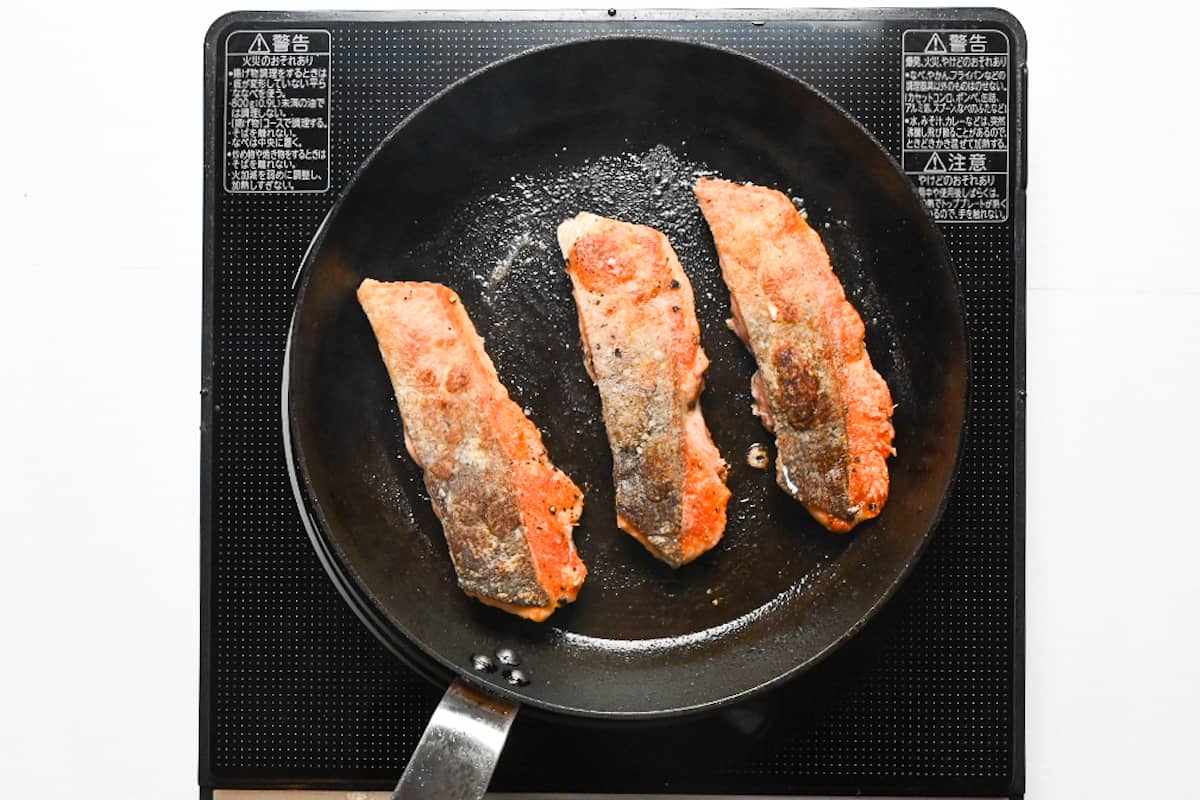
Pour your homemade teriyaki sauce over the salmon.
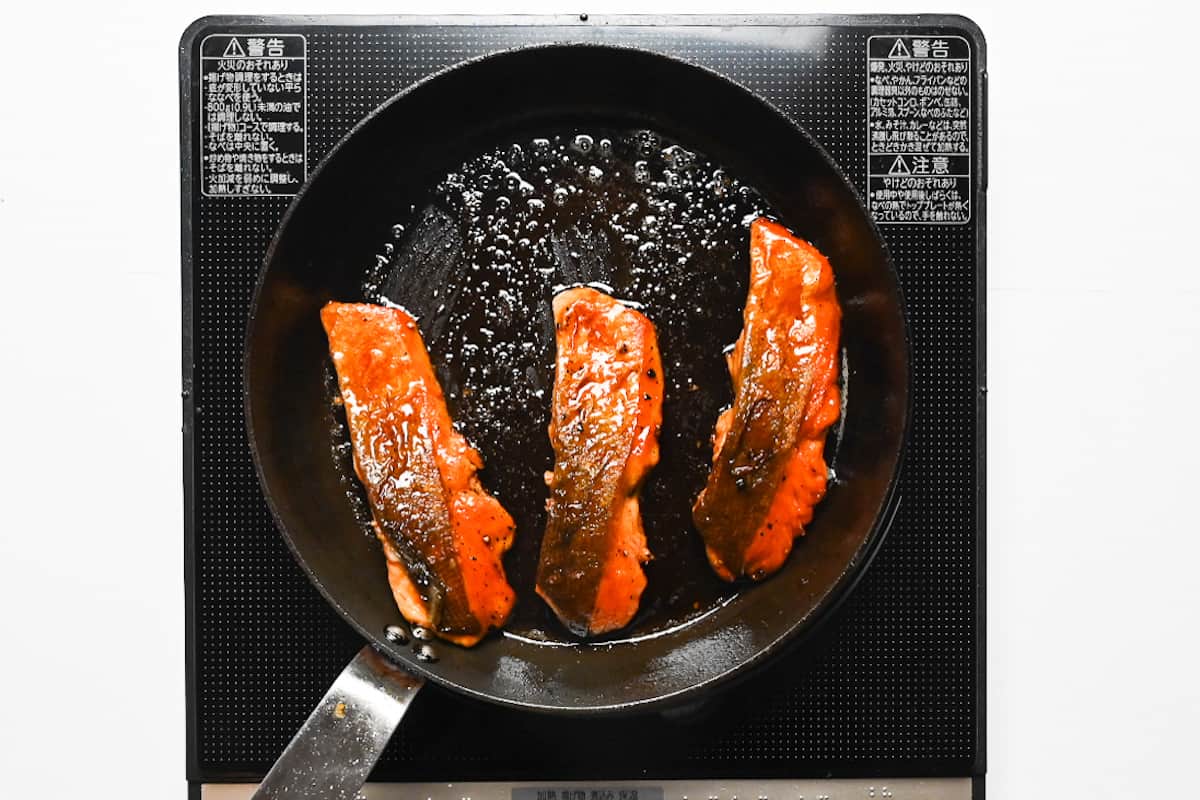
Scoop up the sauce and continuously spoon it over the surface (skin) of the salmon. This is to avoid flipping the salmon again, which can cause it to break once it’s cooked through. It also stops the sauce from burning as it’s being continuously lifted from the pan. You can also gently move the salmon around the pan to make sure the underneath is fully coated too.
Repeat this until the sauce is thickened, and then remove the pan from the heat.
Start by making a bed of rice and placing the buttery spinach on top.
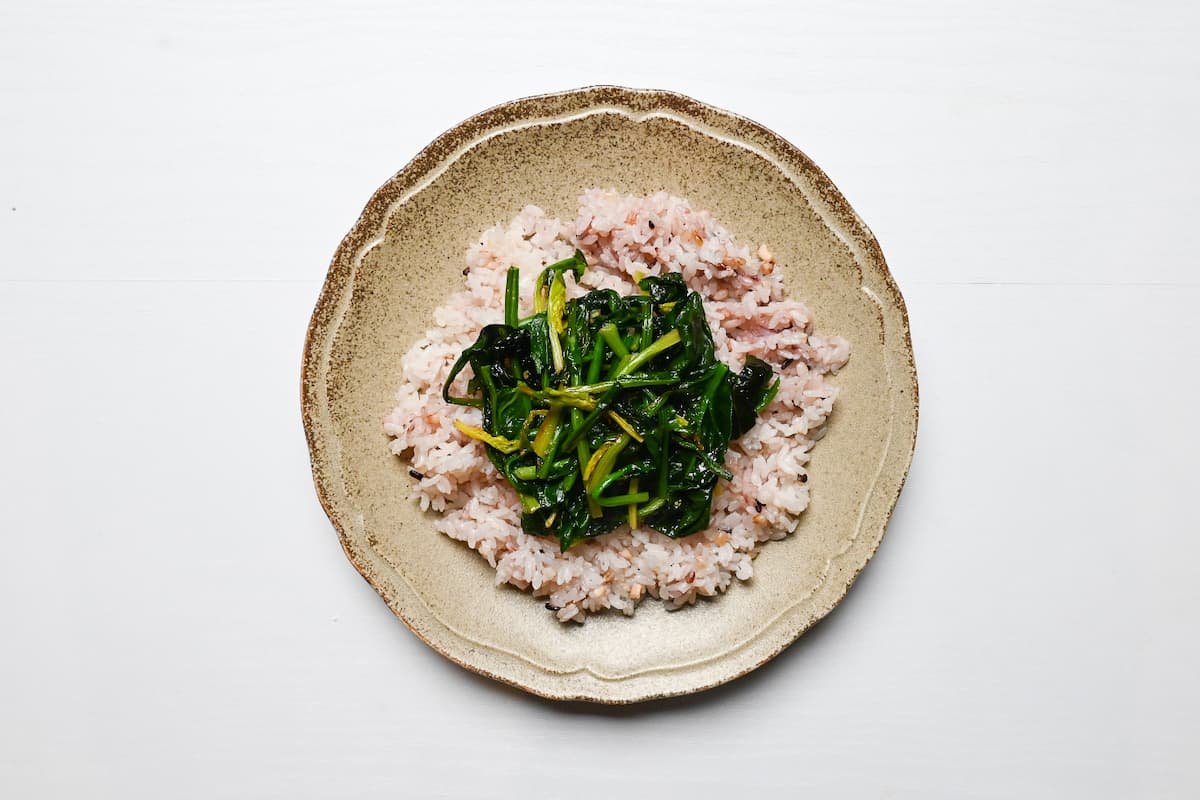
Place the salmon on top of the spinach and arrange the asparagus on the side.
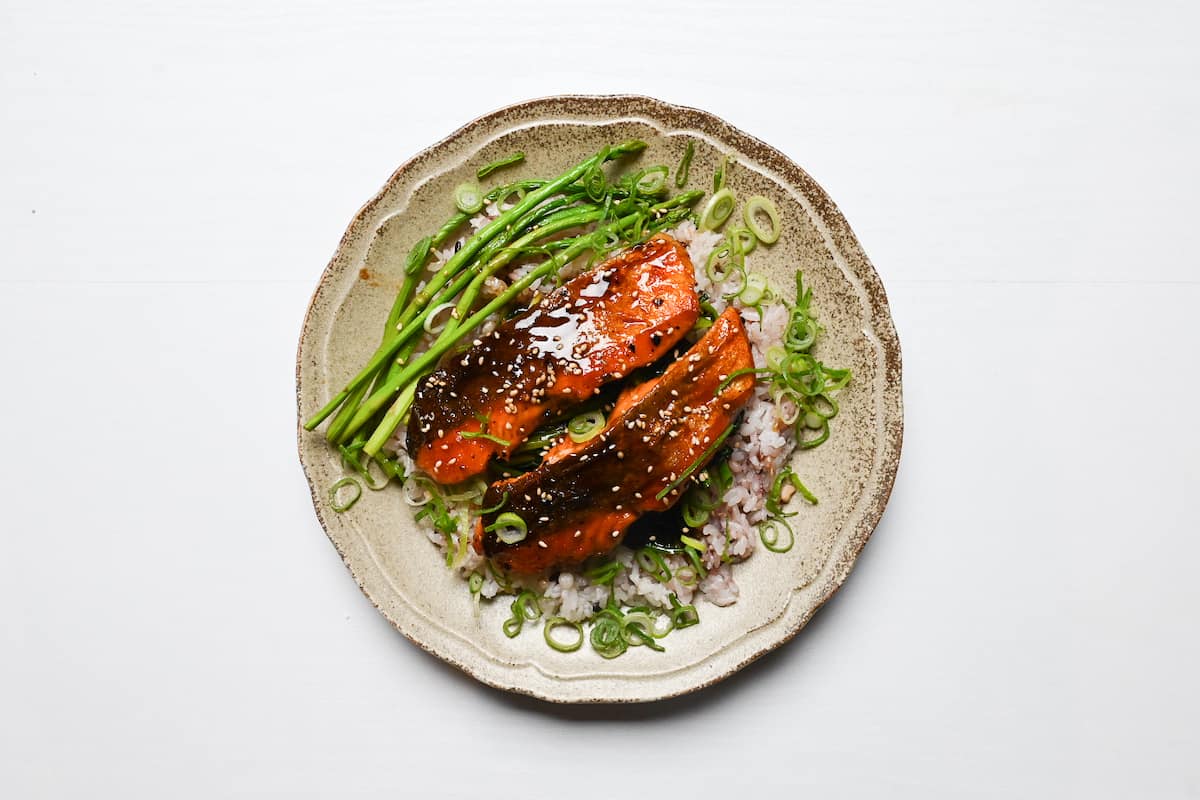
Pour any leftover sauce in the pan over the salmon and sprinkle with toasted sesame seeds. You could also add some chopped spring onions for a final touch.
Enjoy!
Jump to Full Recipe MeasurementsFAQ
Teriyaki only uses 4 ingredients and each one plays an important part. Some recipes don’t use mirin, it’s possible to use more sugar instead of mirin.
Sake is more important and I don’t recommend switching it out. But if you have to, then you can try switching it for Chinese rice wine, dry sherry or even just plain water. (It won’t be so flavourful though.)
Because teriyaki has sugar, it’s better not to marinate. If you do, the sugar will burn when you fry it and it won’t taste so good.
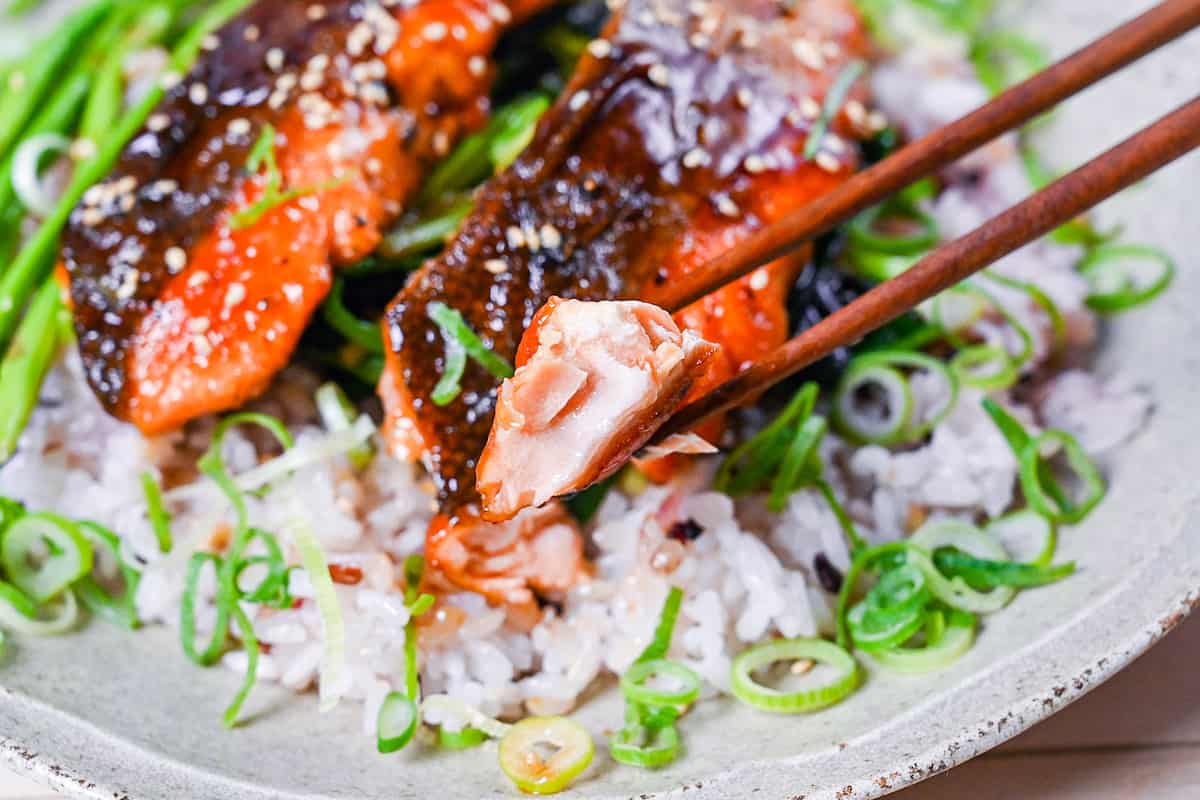
I hope you enjoy this Teriyaki Salmon recipe! If you try it out, I’d really appreciate it if you could spare a moment to let me know what you thought by giving a review and star rating in the comments below. It’s also helpful to share any adjustments you made to the recipe with our other readers. Thank you!
More Delicious Teriyaki Recipes
- Pork Chop Teriyaki with Lemon
- Pan Fried Japanese Teriyaki Salmon
- Teriyaki Beef Rice Bowl with Wasabi Twist
- The Best Crispy Japanese Teriyaki Chicken
Hungry for more? Explore my teriyaki recipe collection to find your next favorite dishes!
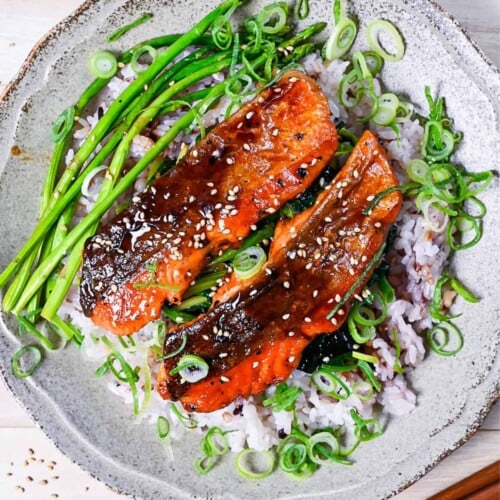
Pan Fried Japanese Teriyaki Salmon
Ingredients
- 100 g Chinese spinach or similar
- 100 g asparagus
- 1 tbsp unsalted butter
- salt and pepper
- 1 ½ tbsp soy sauce
- 1 ½ tbsp mirin
- 1 ½ tbsp sake
- 1 tsp sugar
- 2-4 small salmon fillets skin-on
- 1 tbsp potato starch or corn starch
- 1 tbsp cooking oil like vegetable oil or canola
- 2 portions cooked Japanese short-grain rice
- toasted sesame seeds optional garnish
- finely chopped green onions optional garnish
Instructions
Spinach and asparagus
- Wash 100 g Chinese spinach with cold water and cut it into 3 parts, the stems, the middle and the leaves. Tie each bundle together with butcher's string. (If you're only using the spinach leaves you can skip these steps.)Bring a small pot of water to a boil and add a pinch of salt. Prepare a bowl of ice-cold water next to it.

- Add the spinach stems to the water and set a timer for 1 minute.

- After 1 minute, add the middle part and set a timer for 45 seconds, leaving the stems in.

- After 45 seconds, add the leaves and boil all the spinach together for 30 seconds.

- Transfer all the bundles to the bowl of ice cold water and leave to cool for 1-2 minutes. Gently squeeze the spinach to remove the water and place on a piece of kitchen paper to absorb the excess.

- Heat a pan on medium and melt 1 tbsp unsalted butter. (Alternatively, you can start this step half way through cooking the salmon so that they're ready at the same time.) Add the spinach and 100 g asparagus to the pan along with a pinch of salt and pepper. Stir fry for 2-3 minutes and then remove from the heat. Set aside for later.

Teriyaki salmon
- In a small bowl, mix the 1 ½ tbsp soy sauce, 1 ½ tbsp mirin, 1 ½ tbsp sake and 1 tsp sugar until the sugar is dissolved to make the teriyaki sauce. Set aside for later.

- Heat a frying pan on medium. While it heats, dry the surface of 2-4 small salmon fillets with kitchen paper and sprinkle each side with a pinch of salt and pepper.

- Sprinkle the salmon with 1 tbsp potato starch, rubbing it over both sides to create a thin even layer. Gently tap and brush off any excess starch.

- Once the pan is hot, add 1 tbsp cooking oil and place the salmon fillets in the pan with the skin side down. Fry for approximately 4 minutes or until the skin is crispy.

- Flip the salmon fillets and fry on the other side for 2 minutes.

- Pour the teriyaki sauce over the salmon. Move the salmon around the pan so that the sauce sticks to the bottom and spoon it over the top to coat the skin side.Once the sauce is thick, glossy and the salmon is well covered, remove the pan from the heat.

- Dish up 2 portions cooked Japanese short-grain rice and top with a bed of buttery spinach.

- Place the salmon fillets on top and arrange the asparagus next to them. Pour the leftover sauce from the pan over the salmon and garnish with toasted sesame seeds and finely chopped green onions (optional).

- Enjoy!
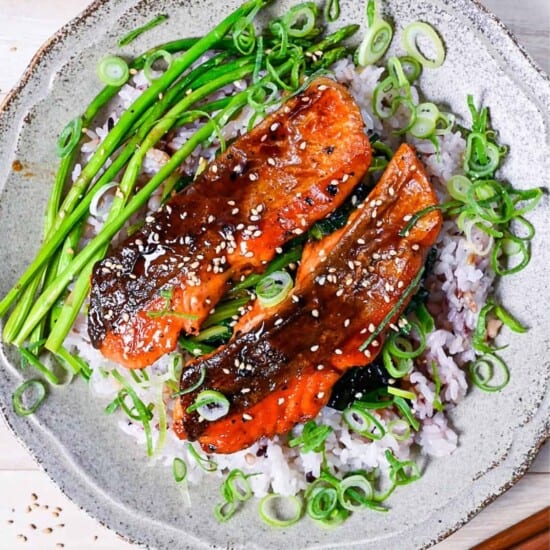



Leave a rating and a comment